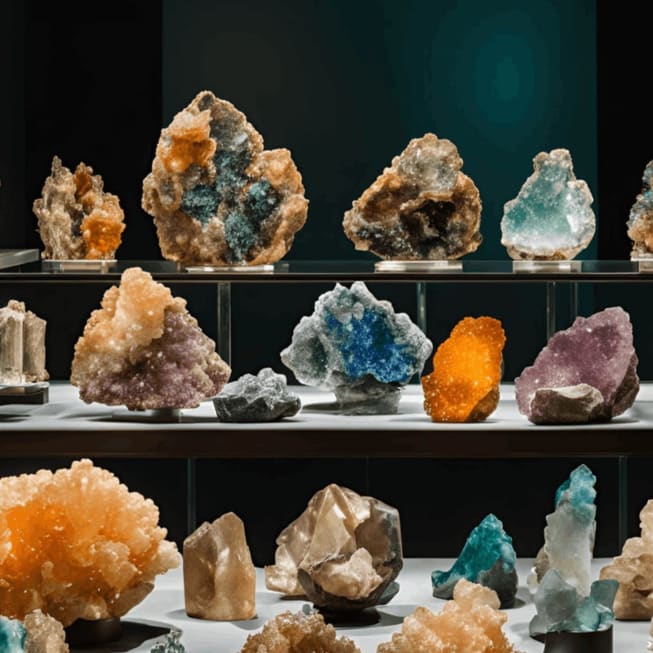Why Do Some Crystals Form Platonic Solids and Geometric Shapes?

Posted on November 19th, 2025
Crystal Structure, Geometry & Metaphysical Meaning
From Fluorite cubes to Garnet dodecahedra and Pyrite’s astonishing geometric symmetry, many crystals naturally grow in forms that mirror the ancient Platonic Solids. These five shapes - the Cube, Tetrahedron, Octahedron, Icosahedron and Dodecahedron - have been recognised for thousands of years as universal archetypes underpinning nature, consciousness and creation. In mineralogy they arise from mathematical precision within a crystal’s atomic lattice; in metaphysics they reveal how geometry shapes energy, intention and spiritual resonance. This article explores why certain crystals form these remarkable geometries, what each Platonic Solid represents energetically, and how these shapes amplify the metaphysical properties of the minerals that express them.
Crystals that grow in geometric shapes reveal how atomic structure becomes visible as perfect form, bridging mineral science with the metaphysical meaning of crystal geometry.
The Platonic Solids take their name from Plato, who associated each of the five perfect geometries with the classical elements. Although his writings popularised them, archaeological artefacts and carved geometric stones show these forms were studied long before ancient Greece. Neolithic carved stone spheres from the Orkney Islands in Scotland, dating to around 3200–2500 BCE, display precise cubic, tetrahedral and dodecahedral patterning, demonstrating that these geometries were understood over a thousand years before Plato. Their perfect symmetry has made them central to sacred geometry and esoteric traditions since antiquity.
What Are the Platonic Solids?
The five Platonic Solids are the only geometries where every face, edge and angle is identical. The Cube, Tetrahedron, Octahedron, Icosahedron and Dodecahedron were viewed in ancient traditions as pure expressions of the elements Earth, Fire, Air, Water and Aether. In sacred geometry they are the building blocks of structure, consciousness and form. In mineralogy, they appear when atomic symmetry aligns with geometric perfection, allowing the inner order of the lattice to become visible in the physical crystal.
Crystal Systems & Lattice Structure — Why Crystals Form Cubes, Octahedrons, Dodecahedrons and Other Platonic Solid Shapes
To understand why some crystals form cubes, octahedrons, dodecahedrons and other Platonic Solid shapes, it is essential to begin with crystal systems. Every mineral belongs to one of seven crystal systems - isometric (cubic), tetragonal, hexagonal, trigonal, orthorhombic, monoclinic or triclinic - each defined by the symmetry and length of their internal axes. These systems reflect the repeating atomic arrangement known as the crystal lattice.
Many people ask “why do some crystals grow as cubes while others form entirely different shapes?” The answer lies in the symmetry of their atomic bonding. When atomic bonds repeat along equal-length axes at ninety-degree angles, the crystal naturally develops a cubic habit. When the symmetry differs, so does the shape.
Atoms bond together at specific angles depending on their chemical structure and ionic radii. These bonds create a repeating three-dimensional pattern which dictates the symmetry of the mineral. When this internal pattern is highly symmetrical, the outer crystal can grow in geometric forms that mirror its lattice symmetry. The mineral’s chemistry determines how atoms lock together; the symmetry of those bonds determines what shapes can appear; and environmental conditions influence which of those shapes the crystal expresses as it grows.
How Do Crystals Grow in These Specific Shapes?
Crystals grow when atoms or ions bond together in repeating patterns determined by their chemical structure. These patterns form the crystal lattice, which stacks in all directions as the mineral grows. The geometry of the lattice dictates the geometry of the crystal. When a mineral belongs to a crystal system where the symmetry matches one of the Platonic Solids, the external habit often expresses that form. Fluorite, Pyrite (and Chalcopyrite), Garnet and Magnetite are among the minerals whose lattices allow Platonic Solid growth habits, producing cubes, octahedra, dodecahedra, icosahedral forms and tetrahedral variants.
Pyrite’s tight isometric order allows cubes, octahedra, dodecahedra and icosahedra, and as Chalcopyrite sometimes expresses tetrahedra, making it the only common mineral to form all five of the Platonic Solids. Fluorite appears as cubes, octahedra and dodecahedra, and does so in all seven colours of the chakra system, allowing all geometric expressions of its energy to manifest across an unusually wide energetic spectrum.
These geometric forms, the Cube, Octahedron, Tetrahedron, Icosahedron and Dodecahedron, each carry their own structural and energetic identity, and they can be explored individually through their elemental correspondences.
The Cube — Earth, Stability, Structure
The Cube corresponds to Earth, grounding, embodiment and stable foundations. Scientifically, cubic crystals arise from lattices where atoms repeat along three equal axes at precise ninety-degree angles. This creates a structure that favours square faces and balanced symmetry. Fluorite is one of the finest natural expressions of cubic geometry, producing perfect cubes across the colour spectrum. Pyrite is equally famous for its machined-looking cubic forms.
Energetically the Cube consolidates, stabilises and densifies energy, anchoring intention into physical reality. A cubic Fluorite or Pyrite directs energy inward and downward, strengthening clarity, discipline and structural support. The grounded, steady energy of cubic crystals is why people commonly search for cubic crystals meaning, they support structure, focus and manifestation. This is why the Fluorite cube meaning is so widely recognised, its geometry amplifies stability, structure and focused awareness.
The cube vs octahedron meaning becomes clear when comparing the grounded weight of a cube with the airy balance of an octahedron.
The Octahedron — Air, Balance, Mental Clarity
The Octahedron corresponds to Air, balance, mental precision and higher perception. It forms when atomic symmetry favours triangular rather than square faces. Magnetite is a classic octahedral mineral, forming natural double-pyramids that align strongly with Earth’s geomagnetic field, making magnetite octahedron meaning a frequent point of interest.
Fluorite also grows in octahedral habit, often revealed through natural cleavage from its cubic form. Energetically the Octahedron refines and clarifies. It balances polarities and supports focused awareness. Octahedral crystals metaphysical meaning centres on clarity, balance and mental integration. This aligns with its association to balanced perception, refined awareness and mental coherence.
The Tetrahedron — Fire, Activation, Will
The Tetrahedron symbolises Fire: ignition, transformation, willpower and catalytic force. Natural tetrahedral minerals are less common, but Chalcopyrite displays this form, and several copper-bearing minerals approximate its symmetry. Energetically the Tetrahedron activates, directs and initiates movement. Its field feels sharp, catalytic and decisive, helping to break stagnation, spark momentum and strengthen will. Tetrahedral crystals meaning is often associated with action, acceleration and the fiery alignment of intention with motion.
The Icosahedron — Water, Flow, Emotional Intelligence
The Icosahedron embodies Water: intuition, emotion, creativity and flow. With twenty triangular faces, it is the most complex of the Platonic Solids. Pyrite occasionally forms near-icosahedral shapes under ideal conditions, creating exceptionally rare examples of Water-aligned metallic geometry. Energetically the Icosahedron softens, harmonises and deepens emotional intelligence. It supports creativity, intuitive knowing and fluid adaptation. Icosahedral crystals meaning resonates with emotional healing, inner flow and the release of tension.
The Dodecahedron — Aether, Higher Consciousness, Subtle Realms
The Dodecahedron corresponds to Aether, the subtle element linking the physical and spiritual realms. Garnet often grows as exquisite dodecahedra aligned with the harmony of the golden ratio. Fluorite and Pyrite may also appear in this geometry.
Energetically the Dodecahedron elevates and expands. It raises awareness, deepens intuition and supports higher-frequency states. In metaphysical practice, dodecahedral crystal meaning is tied to expanded consciousness, subtle spiritual guidance and multidimensional awareness. Among all crystal geometric forms, the dodecahedron is the most subtle and esoteric, carrying what many traditions call the dodecahedron spiritual meaning of Aether and expanded consciousness.
The Interplay Between Crystal Geometry and Energetic Meaning
When a mineral’s crystal system contains the right symmetry, its outer form naturally expresses a Platonic Solid - the Cube (Earth), Tetrahedron (Fire), Octahedron (Air), Icosahedron (Water) or Dodecahedron (Aether). This adds another layer to how a crystal’s energetic identity is shaped.
The interplay of lattice, geometry and metaphysics is why a cubic Fluorite feels grounding, an octahedral Fluorite feels clarifying, and a Pyrite dodecahedron radiates a higher-order intelligence compared to a Pyrite cube. The chemistry is the same, but geometry directs how energy moves. The internal lattice functions as a microcosm of order and symmetry, while the external crystal habit expresses its macrocosmic form; the alignment between the two is what produces each crystal’s unique energetic signature.
The Dual Interplay — Mineral, Geometry & Element: Pyrite as an Example
Every geometric crystal carries a layered energetic identity.
- Mineral metaphysical properties:
The inherent metaphysical nature of the stone. For Pyrite this includes vitality, structure, manifestation and confidence.
- Geometric energetic properties:
The Platonic Solid expressed, such as the Cube for grounding, Octahedron for balance or Dodecahedron for higher consciousness.
Together these form the crystal’s dual energetic signature. A cubic Pyrite expresses Earth-aligned structural manifestation; a dodecahedral Pyrite leans into elevated, intelligent and pattern-harmonising frequencies. Both are Pyrite, yet the energetic experience differs profoundly, which is why people often search for pyrite cube meaning when comparing geometric forms. The Pyrite cube meaning reflects grounded manifestation, while its rarer icosahedral or dodecahedral forms radiate a far more elevated energetic intelligence. This dual interplay explains how geometry refines or intensifies a mineral’s innate metaphysical qualities.
The Triadic Interplay — Colour, Geometry & Mineral: Fluorite’s Full Expression
Fluorite is the perfect example of triadic interplay because it expresses multiple geometries (Cube, Octahedron, Dodecahedron) across an unusually wide colour spectrum. This makes it central to many searches for geometric crystals meaning, sacred geometry crystals and crystal geometric forms.
Polished Rainbow Fluorite
Fluorite is most commonly sold in polished (non-geometric) forms; these polished crystals come from massive Fluorite which has a cubic lattice structure but no cubic, octahedral or dodecahedral habit in its natural growth. The natural metaphysical energy is guided by mineral identity and colour ray alone. A polished Rainbow Fluorite carries the energy of its lattice structure and colour ray, but in a shape that is man-made. In the case of Rainbow Fluorite, this resonates with all chakras and gives clarity to the mind, but without further geometric influence from its natural habit. These man-made shapes are powerful, but far less so than when geometric forms were crafted by Mother Nature and the intelligence of the crystal itself. When you purchase a natural geometric form of Fluorite, it carries a higher level of intelligence encoded into it by nature, expressed as cubes, octahedrons and dodecahedrons.
Cubic Green Fluorite
A cubic Green Fluorite that has naturally grown in the shape of a cube carries its crystal lattice energy and colour-ray energy, but also intensifies grounding, structure and Earth-element qualities through the geometry of the Cube. This is the core of Fluorite cube meaning: clarity anchored through geometric stability. When Green Fluorite is cubic, it resonates with the divine masculine aspect of the heart and is also grounding.
Dodecahedral Purple Fluorite
When growth naturally occurs in dodecahedral habit, Fluorite shifts upward into intuitive perception and higher awareness through the geometry of the Dodecahedron, which resonates with the element of Aether or cosmic awareness. Purple resonance further amplifies spiritual clarity, forming a triadic interplay of mineral intelligence, Aether geometry and upper-chakra colour, making Dodecahedral Purple Fluorite one of the highest-vibrational crystals available.
Other Crystals & the Five Platonic Solids
Many minerals exhibit one or more Platonic Solid habits. Fluorite expresses three: Cube, Octahedron and Dodecahedron. Pyrite expresses all five when Chalcopyrite’s tetrahedra are included. Magnetite forms strong Octahedra, and Garnet grows as natural Dodecahedra. These examples help answer what crystals form Platonic Solids and show the diversity of geometric expression in nature, and have not only the metaphysical properties of the crystal, but also the dual and triadic interplays of geometry, colour and crystal energy.
Crystals that grow in geometric shapes offer a direct view of how lattice symmetry becomes visible through crystal form. One particularly interesting pairing is Garnet and Smokey Quartz together, where Garnet crystals often grow epitaxially on Smokey Quartz points. Some crystals even display complex mixed growth relationships. In rare cases this occurs as epitaxial growth - where the lattice of one mineral aligns with another - such as dodecahedral Garnet forming on Smokey Quartz. This creates striking geometric hybrids that reveal deeper layers of structural order, and examples of Garnet and Smokey Quartz together offer both mineralogical interest and strong metaphysical synergy. Dodecahedral Garnet, in particular, expresses the Aether-aligned geometry of the Dodecahedron, amplifying higher insight, energetic coherence and multidimensional awareness while still grounding through its bond with the Quartz base.
Platonic Solid Crystals in Orgone Devices
When crystals form in Platonic Solid geometries such as the Cube, Octahedron or Dodecahedron, their lattice symmetry translates directly into high‑coherence energetic structure. When these geometric crystals are embedded into Quantum Vortex orgone pyramids or charging plates, the geometry of the stone interacts with the geometry of the device, amplifying coherence, focus and transmission. A dodecahedral Garnet or octahedral Magnetite can significantly elevate an orgone piece, shifting it from a standard design into a multidimensional tool tuned to harmonic resonance and higher-order energetic intelligence.
Many of these geometric crystals also appear in our orgone pyramids and charging plates, as well as in individual mineral specimens, all available through the main shop section for those wishing to work with specific forms.
For readers working with these minerals in practice, each crystal discussed here has a detailed entry within the Crystal A-Z section where its colour, structure and metaphysical qualities can be explored more deeply.
Conclusion
Crystals that grow in Platonic Solid geometries reveal a powerful meeting point between atomic structure, sacred geometry and metaphysical function. Their shapes are not random, they are the natural expression of deep symmetry written into the mineral’s lattice. Understanding crystal sacred geometry meaning becomes clearer when these scientific and energetic aspects are combined.
When you understand how mineral identity, geometric habit and elemental archetype interact, you gain a clearer sense of why a cubic Fluorite feels different from an octahedral one, or why a dodecahedral Pyrite radiates such refined intelligence. Exploring crystals that grow in geometric shapes through this lens enriches meditation, gridwork and all forms of energy healing.
Understanding the geometric foundations of crystals adds depth to meditation, healing and everyday spiritual practice. When you recognise the Cube, Octahedron, Dodecahedron or other Platonic forms in a mineral, you’re reading the language of nature itself — a language that speaks through structure, symmetry and subtle energetic intelligence.
As with all forms of energetic practice, including the use of orgones and crystals, the properties described are intended for informational and spiritual purposes only, and should complement - not replace - professional medical advice, diagnosis or treatment.

Online Store
View our current selection of Orgones and crystals to elevate your Spirit and Space

Quantum Vortex Orgone
Learn about Quantum Vortex Orgones, a combination of science, alchemy and art

Crystals (A~Z)
Learn about Crystals, and how to work with them
